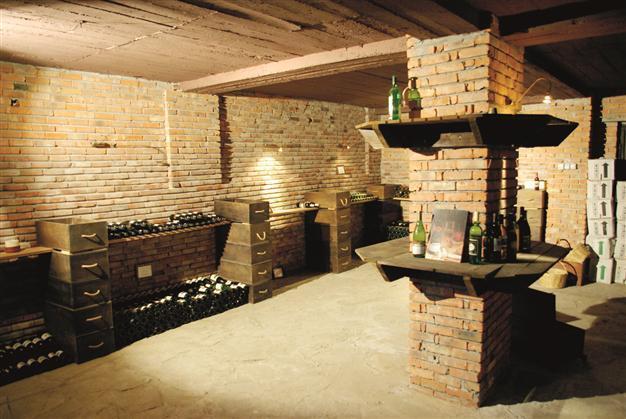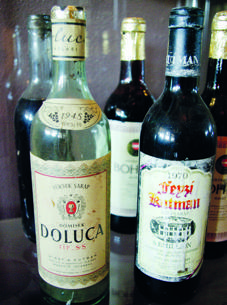Raising a glass to Mürefte
WILCO VAN HERPEN

I have been to Mürefte a couple of times, and every trip has been a pleasant experience. It does not take long to reach Mürefte, located on the Marmara Sea coast in Şarköy, Tekirdağ; from Istanbul, it might take you three hours at most. This is a perfect escape plan for the weekend. Mürefte has a couple of places where you can stay, but don’t expect too much luxury. Just think like this: All you’re doing is spending the night, because during the day, you will be too busy.
About 15 kilometers before you reach Mürefte, there is a strange wooden construction that goes like a pier into the sea. If you’re lucky, people will be catching fish, and it is nice to see how they are doing this. They have a big, square fishnet attached to a mechanism that can pull the net up. All they have to do is lower the net into the sea and wait for the fish to swim above the net. If or when there are enough fish above it the fisherman quickly raises the net and pulls the net toward the place where he is sitting.

The whole pier was made of wood but in such a way that I wondered if it could carry the weight of a single man. The funny thing was that, as far as I could see, there was nothing of value on the pier but in between the land and the sea they placed a door as if it was Fort Knox. I had never seen such a solid door. Unfortunately nobody was there to fish and the door was locked so I was not able to see more of this interesting construction.
Twenty minutes later I was in Mürefte, and it was not hard to deduce what the main source of income for the village is; from the moment I arrived in Mürefte, the characteristic smell of wine filled my nose. It was as if they sprayed wine on the streets to prevent rising dust from irritating the village. Maybe you have seen it before; it is a habit in Turkey during warm days to pour water on the streets for two reasons: The first is to prevent dust from kicking up, and the second is ostensibly cool down the area.
Anyway, my main task was to locate the museum of Adnan Kutman. Located near the sea, a beautiful big building made of brick was the place where Kutman created the first wine museum of Turkey. A couple of huge doors lead into the museum; inside were a number of old machines and tools on display, all of which belonged to his grandfather who had started the business in 1896. Pictures of the old Mürefte decorated the wall, and, naturally, there were many, many bottles and barrels on display.
Adnan explained a bit about the building and its location. The building was characteristic of Rum architecture and had a couple of giant doors. The reason for this is that the people of that time could easily enter with their horses and carriages. From there, it would not be far to the sea where the big sailboats would wait for their precious load.
The grandfather of Adnan, Mr. Kocakotaki, was the initiator of the famous wine house. He was a Rum (an Ottoman Greek) and started with his vines in 1896 on the slopes of the hills around Mürefte. There was no harbor or pier at that time, but the wine farmers of Mürefte nevertheless managed to transport their wines to Istanbul and from there abroad. During the 1900s, a big vineyard disease traveled around Europe and damaged most of the vineyards. Turkey, for some miraculous reason, was not contaminated with this disease and therefore wine farmers from Thrace used this opportunity to export 305 million liters of wine to Europe. All of this was transported via the sea. Little boats would bring the barrels filled with wine to the bigger ships. Each time the sailors could only bring five barrels to the ship so it took a long time to load the ships. Once they were filled with their precious cargo, they would sail off to Constantinople and from there to Europe.

At the moment, Turkey’s wine sector is facing a rough period. While there were (in Mürefte alone) once more than 570 wine houses, there were just 75 by 1990 – a figure that has not risen since. Just when the wine sector was about to become known abroad, they faced a number of changes to the law that made it difficult to continue. Adnan cited this year’s harvest as an example. While before 2007 he would get more than 400,000 tons of grapes for making his wine, he was only able to purchase 1,000 tons this year. That is a big blow for one of the oldest wine houses in Turkey. Slowly, wine producers are escaping to other countries like Romania since the climate is much milder there.
Of course, a visit to a wine house cannot be completed without trying the wine and in the back of the museum, Adnan, with a very gentle move, opened a bottle. The color was beautiful deep red, the tannin slowly slid down the inner side of the glass and the smell was nice and a bit heavy (something in between a Bordeaux wine and a Bourgogne wine). The taste? Well, that was a sensation. I hope that Adnan, and together with him many other wine producers, will be able to smile again soon. The tradition of wine making is a beautiful one, and definitely one that should be cherished.
 I have been to Mürefte a couple of times, and every trip has been a pleasant experience. It does not take long to reach Mürefte, located on the Marmara Sea coast in Şarköy, Tekirdağ; from Istanbul, it might take you three hours at most. This is a perfect escape plan for the weekend. Mürefte has a couple of places where you can stay, but don’t expect too much luxury. Just think like this: All you’re doing is spending the night, because during the day, you will be too busy.
I have been to Mürefte a couple of times, and every trip has been a pleasant experience. It does not take long to reach Mürefte, located on the Marmara Sea coast in Şarköy, Tekirdağ; from Istanbul, it might take you three hours at most. This is a perfect escape plan for the weekend. Mürefte has a couple of places where you can stay, but don’t expect too much luxury. Just think like this: All you’re doing is spending the night, because during the day, you will be too busy. The whole pier was made of wood but in such a way that I wondered if it could carry the weight of a single man. The funny thing was that, as far as I could see, there was nothing of value on the pier but in between the land and the sea they placed a door as if it was Fort Knox. I had never seen such a solid door. Unfortunately nobody was there to fish and the door was locked so I was not able to see more of this interesting construction.
The whole pier was made of wood but in such a way that I wondered if it could carry the weight of a single man. The funny thing was that, as far as I could see, there was nothing of value on the pier but in between the land and the sea they placed a door as if it was Fort Knox. I had never seen such a solid door. Unfortunately nobody was there to fish and the door was locked so I was not able to see more of this interesting construction. At the moment, Turkey’s wine sector is facing a rough period. While there were (in Mürefte alone) once more than 570 wine houses, there were just 75 by 1990 – a figure that has not risen since. Just when the wine sector was about to become known abroad, they faced a number of changes to the law that made it difficult to continue. Adnan cited this year’s harvest as an example. While before 2007 he would get more than 400,000 tons of grapes for making his wine, he was only able to purchase 1,000 tons this year. That is a big blow for one of the oldest wine houses in Turkey. Slowly, wine producers are escaping to other countries like Romania since the climate is much milder there.
At the moment, Turkey’s wine sector is facing a rough period. While there were (in Mürefte alone) once more than 570 wine houses, there were just 75 by 1990 – a figure that has not risen since. Just when the wine sector was about to become known abroad, they faced a number of changes to the law that made it difficult to continue. Adnan cited this year’s harvest as an example. While before 2007 he would get more than 400,000 tons of grapes for making his wine, he was only able to purchase 1,000 tons this year. That is a big blow for one of the oldest wine houses in Turkey. Slowly, wine producers are escaping to other countries like Romania since the climate is much milder there.